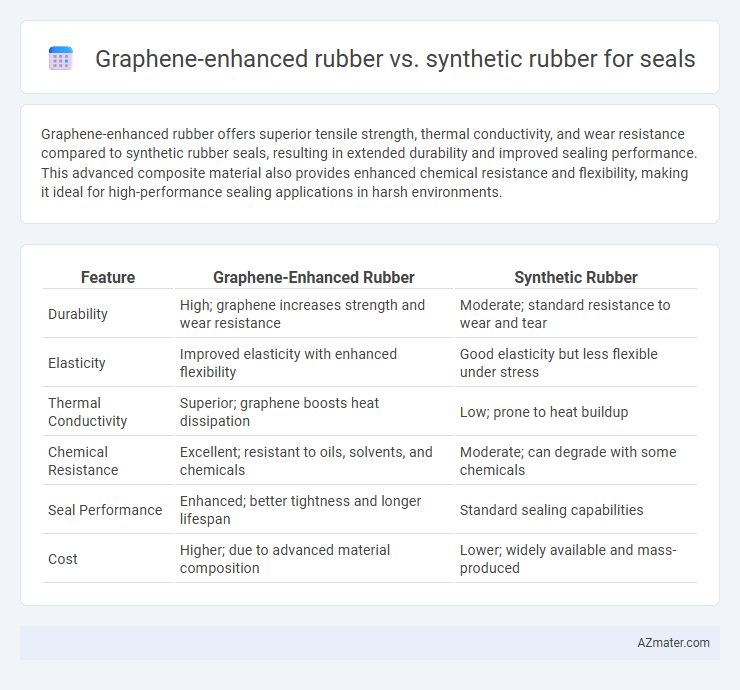Graphene-enhanced rubber offers superior tensile strength, thermal conductivity, and wear resistance compared to synthetic rubber seals, resulting in extended durability and improved sealing performance. This advanced composite material also provides enhanced chemical resistance and flexibility, making it ideal for high-performance sealing applications in harsh environments.
Table of Comparison
| Feature | Graphene-Enhanced Rubber | Synthetic Rubber |
|---|---|---|
| Durability | High; graphene increases strength and wear resistance | Moderate; standard resistance to wear and tear |
| Elasticity | Improved elasticity with enhanced flexibility | Good elasticity but less flexible under stress |
| Thermal Conductivity | Superior; graphene boosts heat dissipation | Low; prone to heat buildup |
| Chemical Resistance | Excellent; resistant to oils, solvents, and chemicals | Moderate; can degrade with some chemicals |
| Seal Performance | Enhanced; better tightness and longer lifespan | Standard sealing capabilities |
| Cost | Higher; due to advanced material composition | Lower; widely available and mass-produced |
Introduction to Rubber Materials in Sealing Applications
Graphene-enhanced rubber exhibits superior mechanical strength, thermal conductivity, and chemical resistance compared to conventional synthetic rubber, making it ideal for sealing applications exposed to extreme conditions. Synthetic rubber, such as nitrile or silicone, remains widely used due to its flexibility, cost-effectiveness, and resistance to oils and weathering. The integration of graphene nanosheets into rubber matrices improves durability, reduces permeability, and enhances overall seal performance, contributing to longer service life and reliability in industrial and automotive seals.
Understanding Synthetic Rubber: Properties and Limitations
Synthetic rubber exhibits strong elasticity, resistance to abrasion, and chemical stability, making it widely used for seals across automotive and industrial applications. However, its limitations include susceptibility to temperature extremes, aging-related brittleness, and reduced mechanical strength under prolonged stress. Graphene-enhanced rubber addresses these issues by improving thermal conductivity, tensile strength, and durability, thereby extending the seal's operational lifespan and performance reliability.
What is Graphene-Enhanced Rubber?
Graphene-enhanced rubber is a composite material integrating graphene sheets into traditional rubber matrices to improve mechanical strength, thermal conductivity, and chemical resistance. This advanced rubber variant exhibits superior durability and enhanced sealing performance under extreme conditions compared to conventional synthetic rubber seals. By leveraging graphene's exceptional nanoscale properties, these seals achieve greater flexibility and longer service life in demanding industrial applications.
Mechanical Strength Comparison
Graphene-enhanced rubber exhibits significantly higher mechanical strength compared to conventional synthetic rubber, with tensile strength improvements reaching up to 50% due to graphene's exceptional load transfer capabilities. The incorporation of graphene nanofillers enhances the rubber's elasticity and tear resistance, resulting in seals capable of withstanding extreme pressure and deformation without compromising integrity. Studies reveal that graphene-reinforced seals maintain superior durability and mechanical performance under harsh operational conditions, outperforming traditional synthetic rubber counterparts.
Chemical Resistance and Durability
Graphene-enhanced rubber exhibits superior chemical resistance compared to synthetic rubber, effectively withstanding harsh solvents, oils, and acids without degradation. The incorporation of graphene significantly improves the durability of seals, offering enhanced tensile strength, resistance to wear, and reduced permeability to gases and liquids. This advanced composite material outperforms conventional synthetic rubber in maintaining seal integrity under extreme chemical and mechanical stress.
Temperature Tolerance: Performance Under Extremes
Graphene-enhanced rubber exhibits superior temperature tolerance compared to conventional synthetic rubber, maintaining elasticity and structural integrity in extreme heat up to 300degC and cryogenic conditions below -70degC. The incorporation of graphene significantly improves thermal conductivity and mechanical strength, reducing degradation and deformation under prolonged thermal stress. This makes graphene-reinforced seals ideal for applications in harsh environments where synthetic rubber typically fails due to brittleness or softening.
Wear and Tear: Longevity of Seals
Graphene-enhanced rubber exhibits superior wear resistance compared to traditional synthetic rubber, significantly extending the longevity of seals in high-friction environments. The incorporation of graphene reinforces the rubber matrix, enhancing its mechanical strength and reducing tear propagation under cyclic stress. This results in seals that maintain integrity and performance over prolonged operational periods, minimizing maintenance and replacement costs.
Cost-Effectiveness and Production Scalability
Graphene-enhanced rubber offers superior mechanical strength and durability, reducing maintenance costs and extending seal lifespan compared to traditional synthetic rubber. While synthetic rubber benefits from well-established production processes and cost advantages at large scales, graphene integration currently faces higher raw material expenses and more complex manufacturing methods. Advances in scalable graphene production and mixing techniques are progressively narrowing the cost gap, positioning graphene-enhanced rubber as a cost-effective option for high-performance sealing applications.
Environmental Impact and Sustainability
Graphene-enhanced rubber offers significant environmental benefits over traditional synthetic rubber, including reduced raw material consumption and enhanced durability, which leads to longer product life cycles and less frequent replacement. The integration of graphene improves mechanical strength and resistance to wear, minimizing waste and energy usage during manufacturing and operation. In contrast, synthetic rubber production relies heavily on petrochemical resources and generates higher greenhouse gas emissions, making graphene-enhanced rubber a more sustainable option for seals.
Choosing the Right Rubber for Sealing: Key Considerations
Graphene-enhanced rubber offers superior tensile strength, excellent thermal conductivity, and enhanced chemical resistance compared to traditional synthetic rubber, making it ideal for high-performance sealing applications. Synthetic rubber, such as nitrile and EPDM, provides cost-effective, versatile solutions with proven resistance to oil, heat, and weathering, suitable for general-purpose seals. When choosing the right rubber for sealing, prioritize factors like operating temperature, chemical exposure, mechanical stress, and longevity requirements to balance performance with budget constraints.

Infographic: Graphene-enhanced rubber vs Synthetic rubber for Seal
 azmater.com
azmater.com